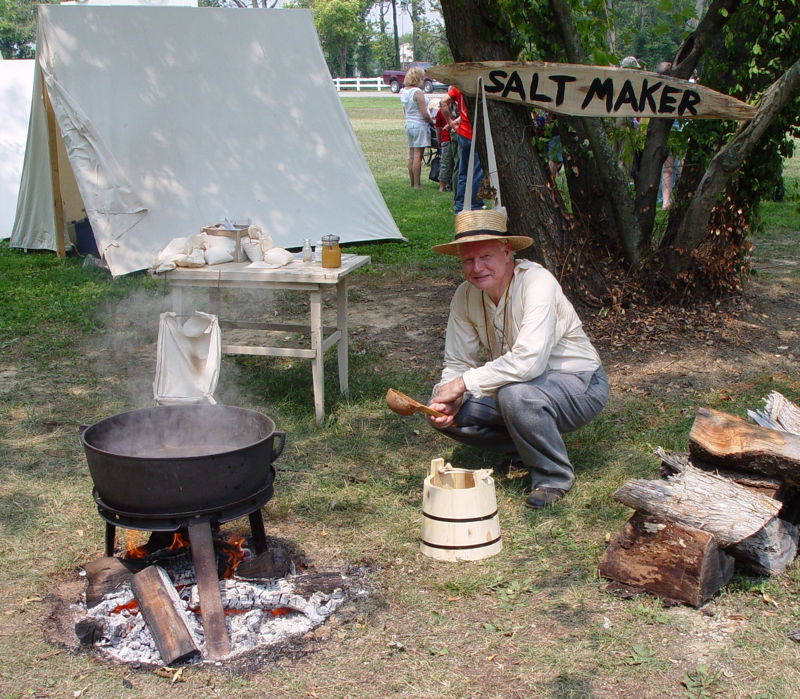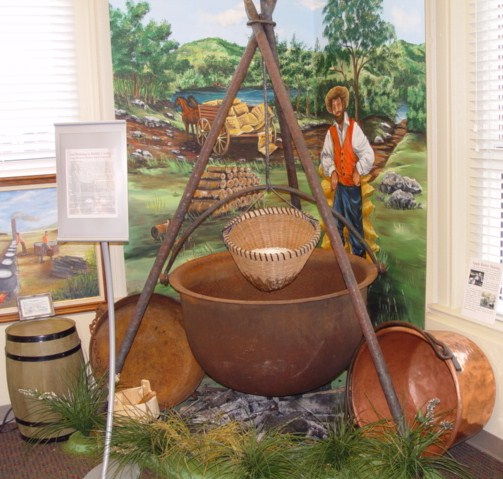
The following article by David Strange originally appeared in The Courier-Journal on 13 Jun 2012. It is archived here with additional information for your reading enjoyment.
"A fair Hell on earth."
That is how one 1790's pioneer described life at a Bullitt County salt works.
Having stood next to a twenty-gallon boiling cauldron in 96 degree weather for nine hours "making salt" myself, I can understand the description.

Salt was once an essential element for survival. Still is, really. But for countless ages before refrigeration came along, salt was used for preserving food, tanning hides, and numerous other needs.
Salt making in Bullitt County was the first industry in Kentucky, starting even before there was a Louisville. It was rough and hot work, but it could be very profitable. Between 1777 and 1830, Bullitt County salt was almost like gold to people as far away as Illinois. It was so profitable that one person traded his land in Oldham County for one iron kettle...and made money! Though salt making in Bullitt County mostly died out by 1830, it briefly picked up again during the Civil War as Southern sympathizers made salt and smuggled it south to the Confederacy.
Union soldiers would try to find the iron kettles and destroy them, so farmers would often hide their valuable kettles by burying them when soldiers were around. Legend has it that there are large stashes of the big kettles still buried around the county.

And big, they were! There is a typical, fifty-gallon, iron salt kettle at the Bullitt County History Museum. I often describe the weight of it as "four men grunting, or three men cussing." At one time, there were many dozens of such kettles being used around the county. Some were as large as seventy gallons.
Of course, one does not actually "make" the salt. The Bullitt County area has a number of natural salt-water springs called "salt licks." A well would be dug at that spot, and the salty water would be boiled down to its natural salt content. Three hundred gallons of water would make about a bushel of salt.
Eventually, local salt making did indeed come to an end. Newly discovered sources of salt in both the North and the South, along with the ability to transport it by steam boat, made it much easier to get salt than our way of boiling down salty water. Thomas Joyce, who was buried around 1878 in the Shepherdsville Pioneer Graveyard next to the riverside park, is recorded as "the last salt maker."
By the way, I did succeed in making the salt myself. After nearly nine hours in blistering heat, and nearly out of my supply of water, I was already telling people that it looked like I failed, when, all of a sudden, the remaining water turned mushy with salt. I got a heaping double-handful of strong-tasting salt, less than a dollar's worth in today's grocery stores.
I remember a friend of mine learned something about local salt making the hard way. Assuming the Salt River to be salty (it's not), he tried his hand at making salt by boiling water from the river. After days of endlessly boiling away water, with no result, he finally learned that the Salt River is not salty. The river was originally named the Salt LICK River, because everyone knew to go up that river to get to the actual salt licks.
And finally, there is another use for salt that we would think terribly gruesome today. As you know, salt was used to preserve meat, such as salt-cured country ham. But you may not know that it was also sometimes used, in basically the same way, to preserve bodies being sent back home during the Civil War. It was not considered very dignified, obviously, but sometimes was the only choice other than being buried where the soldier died. A preferred way was to use a tightly-sealed casket. One group of soldiers near Shepherdsville during the war wanted to send the body of a comrade back home, but they could not get permission to do so unless they could place him in a sealed metal casket. There were none to be found, so they went up to the train tracks and stole enough sheet metal to make one themselves. They made the box, placed their deceased friend inside, and soldered it tight, sending it North on the next train.
Think about that the next time you sprinkle salt on your dinner.
Copyright 2012 by David Strange, Shepherdsville KY. All rights are reserved. No part of the content of this page may be included in any format in any place without the written permission of the copyright holder.
The Bullitt County History Museum, a service of the Bullitt County Genealogical Society, is located in the county courthouse at 300 South Buckman Street (Highway 61) in Shepherdsville, Kentucky. The museum, along with its research room, is open 10 a.m. to 4 p.m. Monday through Friday. Saturday appointments are available by calling 502-921-0161 during our regular weekday hours. Admission is free. The museum, as part of the Bullitt County Genealogical Society, is a 501(c)3 tax exempt organization and is classified as a 509(a)2 public charity. Contributions and bequests are deductible under section 2055, 2106, or 2522 of the Internal Revenue Code. Page last modified: 12 Sep 2024 . Page URL: bullittcountyhistory.org/memories/saltmaking.html